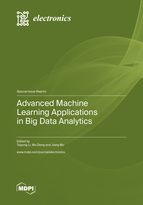Advanced Machine Learning Applications in Big Data Analytics
A special issue of Electronics (ISSN 2079-9292). This special issue belongs to the section "Computer Science & Engineering".
Deadline for manuscript submissions: closed (20 February 2023) | Viewed by 69585
Special Issue Editors
Interests: machine learning; time series analysis; image processing; artificial intelligence
Interests: intelligent diagnosis; optimization algorithm; big data technology
Special Issues, Collections and Topics in MDPI journals
Special Issue Information
Dear Colleagues,
With the development of computer technology and communication technology, various industries have collected a large amount of data in different forms, so-called big data. How to obtain valuable knowledge from these data is a very challenging task. Machine learning is such a direct and effective method for big data analytics. In recent years, a variety of advanced machine learning technologies have emerged, and they continue to play important roles in the era of big data.
This Special Issue is calling for high-quality papers in machine learning algorithms and applications in big data analytics. Topics include but are not limited to the following:
- Machine learning
- Supervised learning
- Unsupervised learning
- Deep learning
- Reinforcement learning
- Lifelong learning
- Transfer learning
- Automated machine learning
- Big data analytics
- Intelligent algorithm
- Image and video analysis
- Text analysis
- Time series analysis
- Energy analysis
- Fault analysis
- Business analysis
- Healthcare data analysis
Prof. Dr. Taiyong Li
Prof. Dr. Wu Deng
Prof. Dr. Jiang Wu
Guest Editors
Manuscript Submission Information
Manuscripts should be submitted online at www.mdpi.com by registering and logging in to this website. Once you are registered, click here to go to the submission form. Manuscripts can be submitted until the deadline. All submissions that pass pre-check are peer-reviewed. Accepted papers will be published continuously in the journal (as soon as accepted) and will be listed together on the special issue website. Research articles, review articles as well as short communications are invited. For planned papers, a title and short abstract (about 100 words) can be sent to the Editorial Office for announcement on this website.
Submitted manuscripts should not have been published previously, nor be under consideration for publication elsewhere (except conference proceedings papers). All manuscripts are thoroughly refereed through a single-blind peer-review process. A guide for authors and other relevant information for submission of manuscripts is available on the Instructions for Authors page. Electronics is an international peer-reviewed open access semimonthly journal published by MDPI.
Please visit the Instructions for Authors page before submitting a manuscript. The Article Processing Charge (APC) for publication in this open access journal is 2400 CHF (Swiss Francs). Submitted papers should be well formatted and use good English. Authors may use MDPI's English editing service prior to publication or during author revisions.
Keywords
- machine learning
- data mining
- data science
- deep learning
- classification
- clustering
- big data analytics
- real-world applications








